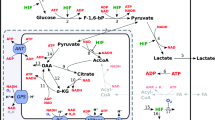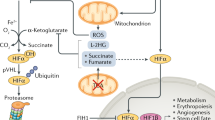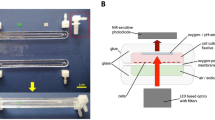Abstract
Expression of specific genes is a strategy of animal cells for adaptation to oxygen deficiency and the mechanism underlying the hypoxic activation of gene expression may be useful for efficient production of recombinant proteins by animal cells, because oxygen is a limiting factor in animal cell cultures. We prepared an animal cell line harboring the plasmid in which expression of a reporter gene, β-galactosidase, is controlled by an enhancer responsible for the hypoxic activation of gene transcription. The purpose of this paper is to understand this hypoxic production of recombinant proteins quantitatively by a mathematical model originally developed based on the following hypotheses; 1 lacZ (the reporter gene) is transcribed after HIF-1 protein complex is bound to the hypoxic enhancer, 2. β-galactosidase synthesis rate is limited at the transcription of lacZ, 3. HIF-1 is an inactive form under a normal oxygen concentration, 4. Oxygen works as a repressor in the synthesis of HIF-1 protein, 5. Both β-galactosidase and HIF-1 are decomposed according to the first order reaction. The effects of hypoxic duration as well as oxygen concentration on the β-galactosidase production were successfully predicated by the model.
Similar content being viewed by others
References
Bunn HF and Poyton RO (1996) Oxygen sensing and molecular adaptation to hypoxia. Physiol. Rev. 76: 839–885.
de Wet JR, Wood KV, DeLuca M, Helinski DR and Subramani S, (1987) Firefly Luciferase Gene: Structure and Expression in Mammalian Cells. Mol. Cell. Biol. 7, 725–737.
Huang LE Arany Z, Livingston DM and Bunn HF (1996) Activation of Hypoxia-inducible Transcriptionu Factor Primarily upon Redox sensitive Stabilization of its α Subunit. J. Biol. Chem. 271(50), 3253–32259.
Jelkmann W (1992) Erythropoietin: structure, control of production, and function. Physiol. Rev. 72: 449–489.
Kelly BD, Chiou TW, Rosenberg M and Wang DIC (1993): In: Rehm HJ, Reed G, Puhler A and Stadler P (eds.) Industrial animal cell culture. Biotechnology. Vol. 3 (pp. 23–38) VCH, Weinheim.
Krantz SB (1991) Erythropoietin. Blood 77: 419–434.
Masuda S, Nagao M, Takahata K, Konishi Y, Gallyas G Jr, Tabira T and Sasaki R (1993) Functional erythropoietin receptor of the cells with neural characteristics: Comparison with receptor properties of erythroid cells. J. Biol. Chem. 268: 11208–11216.
Masuda S, Okano M, Yamagishi K, Nagao M, Ueda M and Sasaki R (1994) A novel site of erythropoietin production: Oxygen-dependent production in cultured rat astrocytes. J. Biol. Chem. 269: 19488–19493.
Masuda S, Chikuma M and Sasaki R (1997) Insulin-like growth factors and insulin stimulates erythropoitin production in primary cultured astrocytes. Brain Res. in press.
Morishita E, Masuda M, Nagao M, Yasuda Y and Sasaki R (1997) Erythropietin receptor is expressed in rat hippocampal and cerebral cortical neurons, and erythropoietin prevents in vitro glutamate-induced neuronal death. Neurosci. 76: 105–116.
Morishita E, Narita H, Nishida M, Kawashima N, Yamagishi K, Masuda S, Nagao M, Hatta H and Sasaki R (1986) Antierythropoietin receptor monoclonal antibody: Epitope mapping, quantification of the soluble receptor, and detection of the solubilized transmembrane receptor and the receptor-expressing cells. Blood 88: 465–471.
Nagao M, Masuda S, Ueda M and Sasaki R (1995) Erythropoietin processing in erythropoietic system and central nervous system. Cytotechnol. 18: 83–91.
Sanes JR, Rubenstein, JLR and Nicolas JF (1986) Use of a recombinant retrovirus to study post-implantation cell lineage in mouse enbryos. EMBO J. 5, 3133–3142.
Semenza GL, Nejfelt MK, Chi SM and Antonarakis SE (1991) Hypoxia-inducible nuclear factors bind to an enhancer element located 3′ to the human erythropoietin gene. Proc. Natl. Acad. Sci. USA 88, 5680–5684.
Tsuchiya T, Ueda M, Ochiai H, Imajoh S and Kanegasaki S (1993) Erythropoietin 5'-Flanking Sequence-Binding Protein Induced during Hypoxia and Gobalt Exposure. J. Biochem 113, 395–400.
Wang GL, Jiang B-H, Rue EA and Semmenza GL (1995) Hypoxia-inducible factor 1 is a basic-helix-loop-PAS heterodimer regulated by cellular O2 tension. Proc. Natl. Acad. Sci. USA 92, 5510–5514.
Wang GL, Jiang B-H, Rue EA and Semmenza GL (1995) Effect of Altered Redox States on Expression and DNA-Binding Activity of Hypoxia-Inducible Factor 1. Biochem. Biophys-Res. Commin. 212(2), 550–556.
Wiener, CM, Booth G and Semenza GL (1996) Biochem. Biophys. Res. Commun. 225, 485–488.
Rights and permissions
About this article
Cite this article
Shirai, Y., Inagaki, M., Yamaguchi, M. et al. Effect of hypoxia duration on the oxygen-dependent production of a recombinant protein, β-galactosidase, by an animal cell line, F6D2, with a hypoxia-inducible enhancer. Cytotechnology 25, 71–77 (1997). https://doi.org/10.1023/A:1007911816292
Issue Date:
DOI: https://doi.org/10.1023/A:1007911816292




